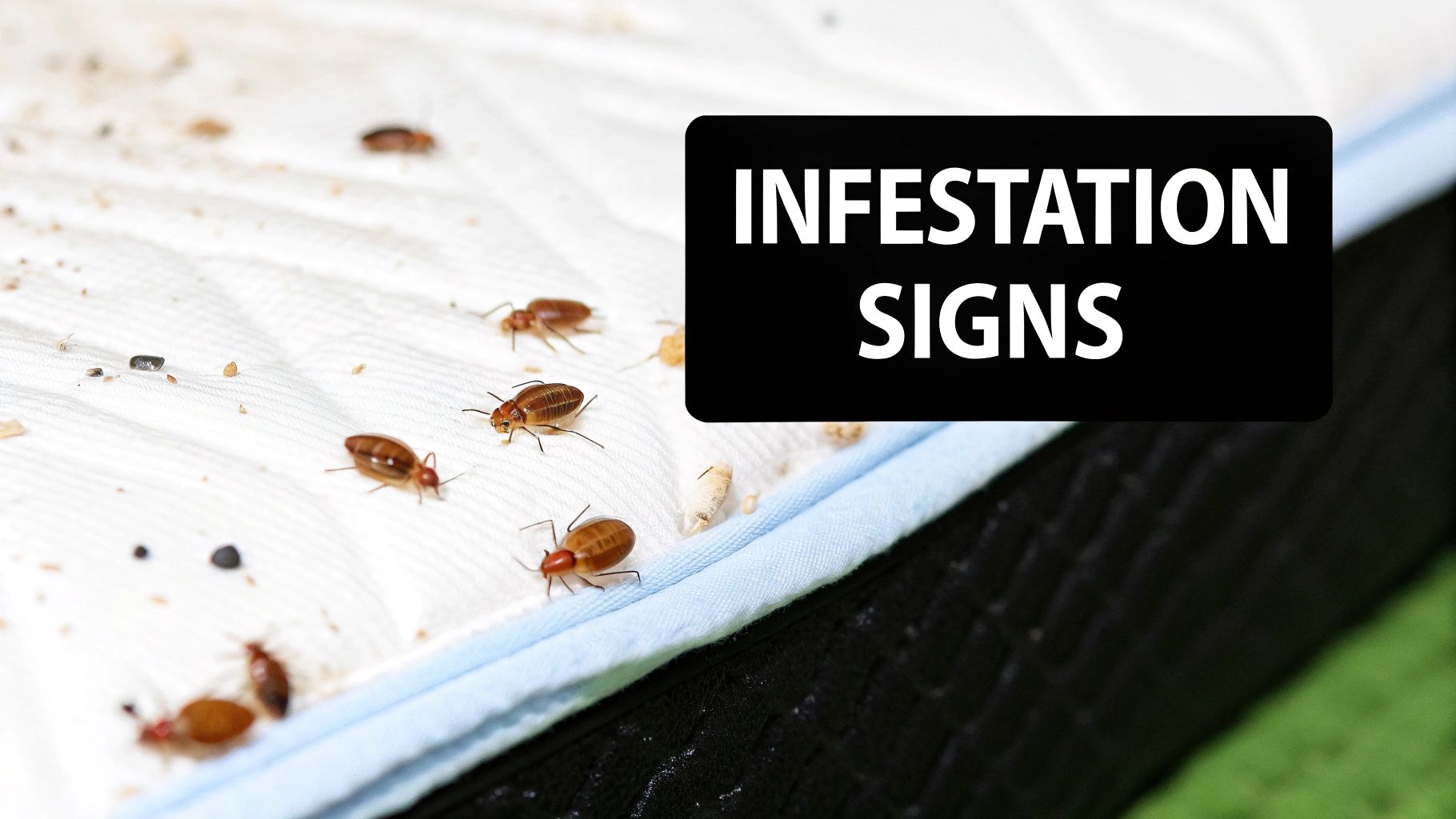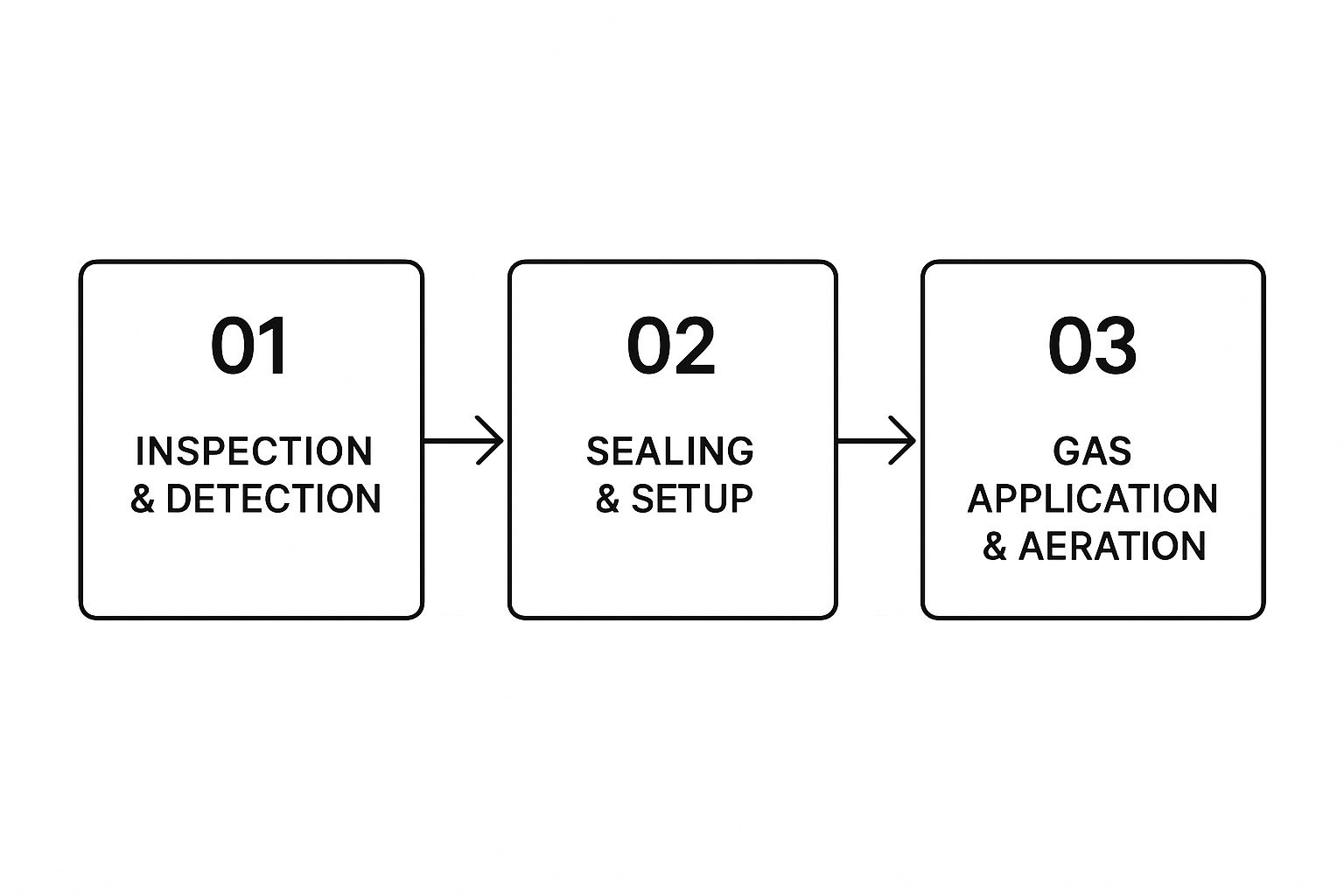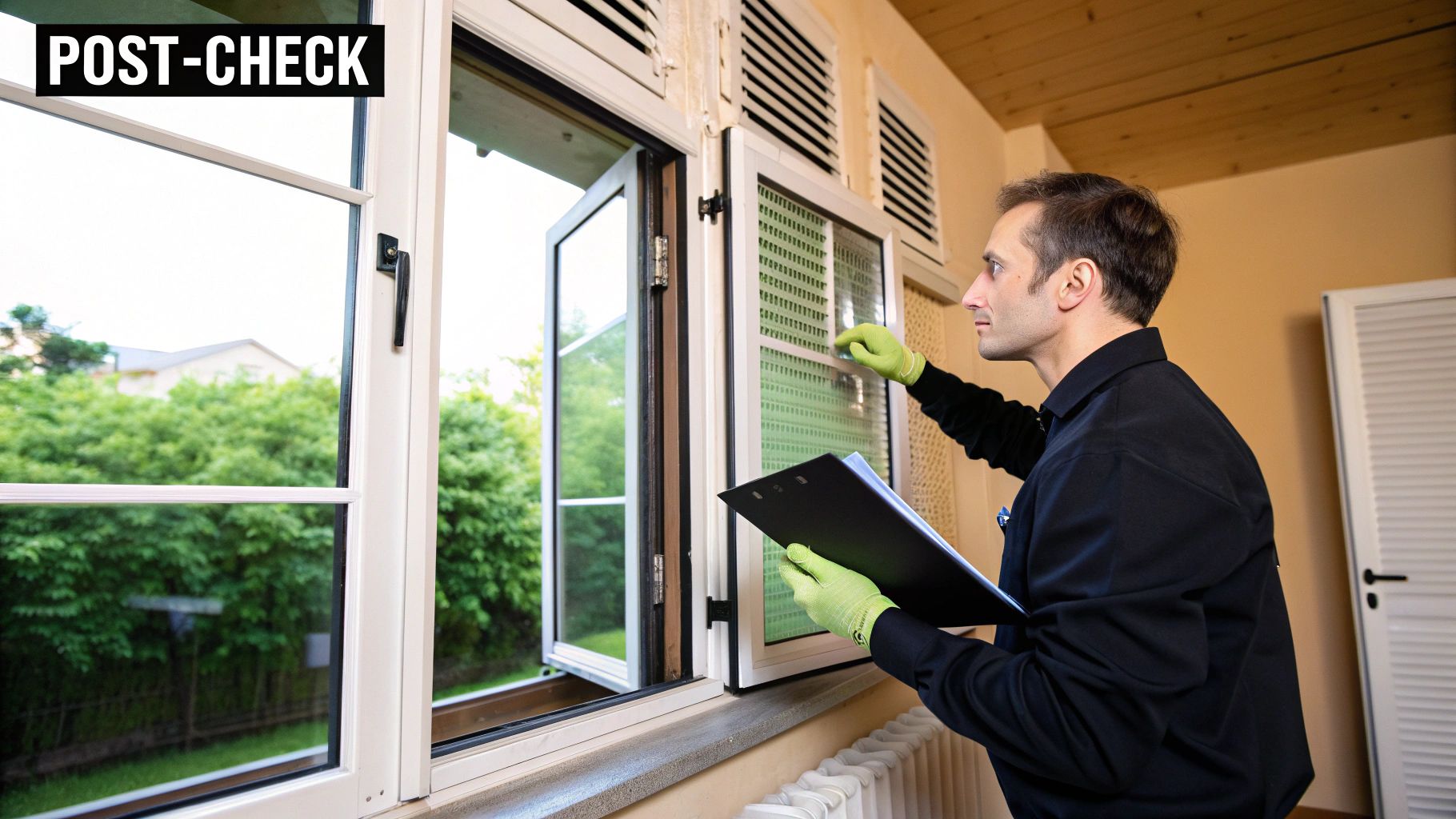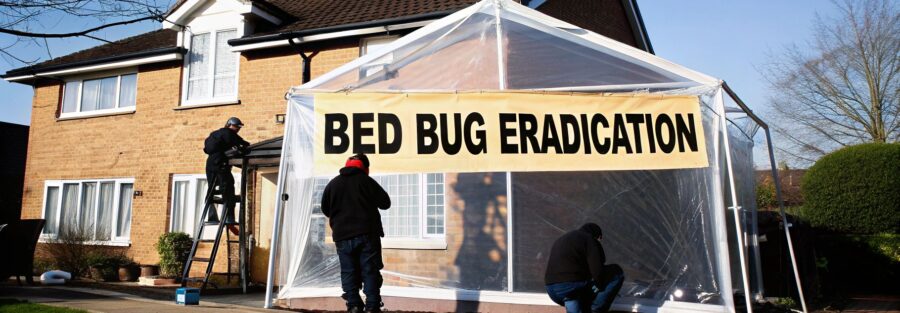Feeling like you're fighting a losing battle against bed bugs? When a problem gets so bad that it feels like the pests are literally in the walls, it might be time for the nuclear option: whole-structure fumigation. This is the complete ‘reset’ button for your home, a professional-grade solution for severe infestations.
It’s a highly specialised process where experts use a fumigant gas to get rid of every single pest, even the ones hiding in places you’d never think to look.
What Fumigation for Bed Bugs Really Means

When the usual spot treatments and sprays aren’t cutting it, it’s almost always because they can't reach every hideout. Bed bugs are masters of concealment, tucking themselves into mattress seams, behind skirting boards, inside electrical outlets, and deep within the guts of your furniture. This is where a whole-structure approach truly shines.
Think of it this way: spot treatments are like playing whack-a-mole. You deal with the pests you can see, but you’re not addressing the source. Fumigation, on the other hand, is like flooding the entire game board. It gets into every nook and cranny, leaving no place for them to hide.
The Science of Total Eradication
The process of fumigation for bed bugs is a serious undertaking. It involves sealing the entire property—often by covering it with a massive, heavy-duty tent. Once the building is completely airtight, a precisely calculated amount of fumigant gas is pumped inside.
This gas is designed to be lighter than air, which allows it to seep into every conceivable space. It permeates everything from wooden beams and wall voids to the stuffing inside your sofa. Nothing is off-limits.
This is what makes it so brutally effective. The gas reaches bed bugs at all stages of their life cycle, including the notoriously tough eggs that most contact insecticides can’t kill.
A key advantage of fumigation is its ability to overcome the limitations of liquid or dust-based treatments. While other methods rely on direct contact, a fumigant gas actively seeks out every nook and cranny, ensuring no pocket of infestation is overlooked.
The UK's Powerful Alternative: Heat Treatment
Here in the UK, traditional gas fumigation for residential bed bug jobs is less common. Instead, we have an equally powerful whole-structure method: heat treatment. It achieves the exact same goal of total annihilation, just through a different mechanism.
Rather than using a gas, professionals bring in specialised industrial heaters to slowly and safely raise the temperature inside your home to a level that is lethal for bed bugs—usually somewhere between 50°C and 60°C.
This intense, permeating heat works just like a fumigant, penetrating all areas and killing bed bugs and their eggs wherever they are.
Both methods are considered the gold standard for a simple reason: they are designed to achieve a 100% kill rate. When you're dealing with a widespread, persistent bed bug problem, understanding why a whole-property treatment works is the first step to finally getting rid of them for good.
Your Step-by-Step Treatment Day Walkthrough
Wondering what actually happens on treatment day can be a source of anxiety. But a professional whole-house treatment isn't just one big event; it's a meticulously planned process. From the first phone call you make to the moment you step back into your pest-free home, every stage is designed for one thing: getting the job done right, safely.
Let’s pull back the curtain and walk through the entire journey. Knowing what the pros are doing, and what your role is, makes for a much smoother and more successful outcome.
Step 1: The Initial Inspection and Diagnosis
It all starts with a proper look around. A qualified technician will visit your property to get the full picture, figuring out just how bad the bed bug infestation is and how far it has spread. This is far more than a quick glance.
Think of it as detective work. They’ll check the obvious hotspots like your mattress, bed frame, and sofa, but their trained eye knows to look in the less-obvious places, too—behind picture frames, inside electrical outlets, or along the edges of your skirting boards. This diagnostic phase is absolutely vital. It confirms if a whole-house treatment is the right call and helps the team calculate exactly what’s needed, whether that’s the amount of fumigant or the time needed for a heat treatment. It’s the foundation for the entire battle plan.
Step 2: The Crucial Preparation Phase
Once the inspection is done and you’ve agreed on a plan, the spotlight turns to you. Your preparation isn’t just a helpful suggestion; it’s a critical part of making the treatment work. Your pest control company will give you a detailed checklist of everything you need to do before they show up.
This nearly always includes:
- Washing and Drying Fabrics: All your bedding, curtains, and clothes need to be washed and then dried on the highest heat setting your machine can handle. This heat blast kills any bed bugs or eggs hiding in the material.
- Bagging and Sealing: Once laundered, pop everything into heavy-duty plastic bags and seal them tight. This stops any stray bugs from getting back in before or during the treatment.
- Decluttering Spaces: Clearing clutter off floors and surfaces is a big one. It removes potential hiding spots and ensures the gas or heat can get everywhere it needs to go.
Following these instructions to the letter is essential. If prep work is skipped, it can create "cold spots" during a heat treatment or block the fumigant from reaching infested nooks and crannies. This can easily lead to treatment failure and the headache of having to do it all over again.
Step 3: Treatment Day Execution
On the big day, the professional team takes the reins. The exact process will vary a bit depending on the method, but the goal is always the same: total eradication.
If you’re going with traditional fumigation for bed bugs, the team will start by wrapping your entire property in a massive, heavy-duty tent. This creates an airtight seal, which is crucial for keeping the fumigant gas contained. Once sealed, the gas is pumped in and monitored for anywhere between 24 to 72 hours to make sure it penetrates every single inch of your home.
For a heat treatment, technicians bring in specialised heaters and powerful fans, placing them strategically throughout the house. They use a network of temperature sensors to keep a close eye on every room, ensuring the entire structure hits and stays at the kill-zone temperature of at least 50°C for several hours. This intense, sustained heat gets deep into furniture, walls, and all your belongings.

Step 4: Aeration and Safety Clearance
After the treatment time is up, the final—and most important—phase begins: making your home safe to return to. For a fumigation, the tent comes off and the property is left to air out. Technicians use special gear to test the air quality, checking that every trace of the fumigant has dissipated to safe levels.
You will not be allowed back into your home until a professional has officially certified it as safe. This is a non-negotiable safety measure to protect you and your family.
It's a similar story after a heat treatment. The equipment is removed, and the house is allowed to cool down naturally. Once the pros give you the all-clear, you can finally walk back into a home that's free from the grip of bed bugs.
How to Prepare Your Home for Treatment

Getting rid of bed bugs for good is a team effort. While our technicians arrive with the expertise and high-grade equipment, the work you do beforehand is absolutely crucial to the treatment's success. Think of it like preparing a room for a decorator – the better the prep, the better the final result.
Proper preparation ensures the fumigant or heat can penetrate every last nook and cranny where a bed bug might be hiding. If you skip these steps, you risk leaving safe havens for them to survive, which can lead to a frustrating and costly re-infestation down the line. Let's walk through exactly what you need to do to guarantee total wipeout.
Managing Clothing and Linens
Bed bugs are notorious for hiding in fabrics, which is why your first job is to tackle every piece of clothing, bedding, and textile in the affected rooms. This isn't just about being tidy; it's a vital part of the extermination itself.
Every fabric item needs to be treated. This means:
- Bed sheets, duvet covers, pillowcases, and blankets.
- All clothing from wardrobes and drawers, even if you think it's clean.
- Curtains, towels, and even soft toys.
The process is simple but non-negotiable. Wash everything you can on a hot cycle, but the most important step is drying it on the highest possible heat setting for at least 30 minutes. It's the intense, dry heat of a tumble dryer that kills both adult bed bugs and their eggs. Once an item is treated, pop it straight into a heavy-duty, sealable plastic bag to keep it safe from re-infestation.
Declutter and Create Space
Clutter is a bed bug’s best friend. It gives them an endless maze of hiding spots, making it nearly impossible for any treatment to be fully effective. Your mission here is to create clear, open spaces.
Work your way through each room, getting rid of anything you no longer need – old magazines, papers, and especially cardboard boxes. For items you're keeping, store them in sealed plastic containers. This isn't just about tidying; it's about removing the enemy's cover.
One of the most critical steps is to move all furniture at least 30 centimetres (about a foot) away from the walls. This creates a clear path around the room, allowing our technicians to treat skirting boards, wall voids, and the back of furniture—all prime bed bug real estate.
Home Preparation Checklist Before Fumigation
To make things easier, we've put together a checklist of the essential tasks you'll need to complete before the pest control team arrives. Following this list gives us the best possible chance of achieving a 100% successful treatment on the first go.
| Item Category | Action Required | Reason |
|---|---|---|
| People & Pets | Relocate all people, pets (including fish and reptiles), and houseplants from the property for the entire treatment period. | To ensure the safety of all living things from the fumigant or intense heat. |
| Food & Drink | Remove all unsealed food, open drinks, pet food, and medications. | To prevent contamination. Canned goods or food in airtight glass/metal containers are safe. |
| Clothing/Linens | Wash and dry all fabrics on high heat for 30+ minutes. Seal in clean plastic bags immediately. | High heat kills all life stages of bed bugs. Sealing prevents re-infestation before treatment. |
| Furniture | Pull all furniture at least 30cm (1 foot) away from walls. | This provides clear access to treat skirting boards, outlets, and the perimeter of the room. |
| Clutter | Remove and dispose of unnecessary clutter (magazines, papers, boxes). Store essential items in sealed plastic tubs. | Eliminates hiding spots and allows the treatment to penetrate all areas effectively. |
| Electronics | Unplug all electronics. Your technician will advise if certain sensitive items need to be removed or specially protected. | To prevent any potential damage from heat or chemicals and ensure safety. |
| Access | Ensure technicians have unobstructed access to all rooms, cupboards, and wardrobes. | Full access is necessary for a thorough and comprehensive treatment application. |
Completing these steps isn't just helpful; it’s a fundamental part of the pest control process that directly impacts the outcome.
Securing and Removing Key Items
Certain items simply can't be left in the house during a fumigation for bed bugs or heat treatment. Your pest control team will give you a specific list, but here’s a general rundown of what to plan for:
- All People and Pets: Every single person and animal must be out of the property for the entire treatment and the following aeration period. This includes fish in tanks and reptiles.
- Food and Medication: As mentioned, all unsealed food and medicines have to go. Items in airtight glass or metal containers are usually fine to stay.
- Houseplants: The fumigant or high heat will kill them, so move them outside or to an untreated building like a shed or garage.
- Valuables and Sensitive Items: While not always necessary, you might feel more comfortable removing irreplaceable items like musical instruments, important papers, or delicate artwork. Have a chat with your provider about this.
Bed bugs are a widespread issue in the UK, found everywhere from luxury flats to public transport, which is why such thorough prep is vital. The UK pest control industry is growing, expected to hit a revenue of £683 million by 2025, partly because resilient pests like these demand professional solutions.
While you're focused on bed bugs, keeping your bedroom hygienic is key. You might also find it useful to start understanding common bed-related pests like dust mites to make sure your bedroom is a true sanctuary. By taking these preparation steps seriously, you become an active partner in reclaiming your home from these unwanted guests.
Understanding the Safety Measures and Protocols
Handing your home over for a full-scale treatment like fumigation for bed bugs can feel like a massive leap of faith. The thought of potent gases or intense heat being pumped into the place where you live, sleep, and eat is enough to make anyone a bit nervous. But it’s vital to understand that professional treatments aren’t just a casual spray-down; they’re governed by incredibly strict safety protocols.
This is a highly controlled, scientific process. From the moment the certified technicians arrive, every move they make is deliberate, with safety as the top priority. They're trained and equipped with specialised tools to ensure the treatment is not only lethal to bed bugs but also perfectly safe for you and your family to return to.
Creating a Contained and Controlled Environment
The first rule of any whole-structure treatment is containment. For fumigation, this means creating a completely airtight seal around your property, usually with heavy-duty, specialised tarps. This crucial step ensures the fumigant is precisely contained where it needs to be and cannot escape into the surrounding area, protecting your neighbours and the local environment.
It’s a similar story with heat treatments, where the property is sealed up to maintain that critical high temperature. Throughout either process, professionals rely on sophisticated monitoring equipment.
- Continuous Air Monitoring: During fumigation, sensors are placed to make sure the gas concentration hits the level needed to kill every last bed bug, while confirming it stays safely inside the tent.
- Temperature Probes: For heat treatments, multiple sensors are strategically placed in hard-to-reach spots, guaranteeing every nook and cranny hits the lethal temperature without causing any damage.
This constant, precise monitoring is what sets a professional service apart from a risky DIY attempt. It’s all about control.
The Aeration and Re-Entry Protocol
Once the treatment time is up, the job is far from over. The final, and arguably most critical, safety step is the aeration and clearance phase. You, your family, and your pets will need to stay away from the property during this entire time, which typically lasts from 24 to 72 hours. The exact time depends on the treatment and the size of your home.
Technicians will not let you back in until they have officially certified that the home is 100% safe. Using specialised detection instruments, they measure the air to confirm fumigant levels have dropped to zero or that temperatures are back to normal. This isn't just a suggestion—it's a non-negotiable legal and ethical requirement.
To be absolutely certain the air is clear of any lingering fumigants after treatment, professionals often use specialised VOC monitoring and analysis to confirm the property is safe for re-entry. This verification is your ultimate peace of mind.
Protecting Your Valuables and Sensitive Items
While the process is perfectly safe for your home's structure, some of your belongings will need a bit of special care. The extreme conditions can potentially damage delicate items. Your pest control expert will give you a detailed list, but as a rule of thumb, you should plan to protect or remove these things:
- Electronics: While most electronics can handle it, unplugging them is standard. You might want to remove particularly sensitive gear like high-end computers or servers just to be safe.
- Musical Instruments: Anything made of wood, like guitars, pianos, or violins, is especially vulnerable to damage from intense heat or chemical exposure. Always take them out.
- Artwork and Antiques: Oil paintings, delicate fabrics, and certain antique wood finishes can be affected. When it comes to irreplaceable items, it's always best to err on the side of caution and remove them.
- Wax-Based Items: Candles, wax figures, and even some makeup can melt during a heat treatment, so make sure they're moved out beforehand.
By following the preparation checklist your provider gives you and trusting their safety protocols, you can be confident that fumigation for bed bugs is a truly reliable and secure way to reclaim your home.
Comparing Your Bed Bug Treatment Options

Choosing a bed bug treatment can feel overwhelming. While powerful, whole-property solutions like fumigation and heat treatment are the definitive answer for severe infestations, they aren’t the only tools in a pest controller’s box. Understanding the full spectrum of methods helps you see why a particular approach is recommended for your unique situation.
The key is matching the treatment to the scale of the problem. Spotting a few bed bugs on a mattress doesn't necessarily call for the same response as a deep-rooted infestation that has spread throughout your entire home. Let's compare the most common methods, focusing on what matters most: effectiveness, cost, and the level of disruption to your life.
Whole-Structure Treatments: The Heavy Hitters
When an infestation is widespread, you need a solution that leaves no stone unturned. This is where whole-structure treatments come in, designed for total eradication.
- Heat Treatment: This is the UK’s leading method for whole-house bed bug elimination. By raising the temperature of your home to a consistent 50-60°C, it kills bed bugs and their eggs wherever they're hiding, from deep inside furniture to wall cavities. It’s incredibly effective and chemical-free. Learn more about how professional heat treatment can eliminate bed bugs and textile pests in our detailed guide.
- Gas Fumigation: While less common for residential jobs in the UK, traditional fumigation works by filling a sealed property with a potent gas. Like heat, its key advantage is penetration, reaching every single crack and crevice to guarantee a 100% kill rate.
These methods are the most powerful and reliable options for moderate to severe infestations where targeted treatments would likely fail. They're an investment, but they offer the closest thing to a guaranteed fresh start.
Targeted Treatments For Localised Issues
When you catch a bed bug problem early and it's confined to a small area, more localised treatments can sometimes do the trick. These methods are less disruptive and generally more affordable, but they lack the comprehensive reach of whole-structure solutions.
Chemical Sprays and Insecticides: Professional-grade liquid insecticides are a common tool. A technician applies these chemicals directly to known hiding spots like bed frames, skirting boards, and furniture seams. While effective on contact, their success depends entirely on reaching every single bug.
The biggest challenge with chemical sprays is that bed bugs are masters of hiding. If even a few eggs or adults are missed in an untreated area, the infestation can rebound within weeks.
Steam Treatment: High-temperature steam is a chemical-free way to kill bed bugs and their eggs on contact. It’s excellent for treating surface areas like mattresses, sofas, and curtains. However, steam can't penetrate deep into walls or dense furniture, making it a spot treatment rather than a complete solution.
Diatomaceous Earth (DE): This is a natural, abrasive powder made from fossilised algae. When bed bugs crawl over it, DE scratches their waxy outer layer, causing them to dehydrate and die. It’s often used in cracks and crevices as a long-term deterrent but is slow-acting and ineffective against a large, active infestation on its own.
Bed Bug Treatment Method Comparison
Trying to decide which approach is right? This table provides a clear, side-by-side look at how these options stack up, helping you understand why a professional might recommend one over another.
| Treatment Method | Effectiveness | Average Cost | Chemical Use | Best For |
|---|---|---|---|---|
| Heat Treatment | Excellent (99-100% Kill Rate) | High | None | Severe, widespread, or multi-room infestations. |
| Fumigation | Excellent (99-100% Kill Rate) | High | High | Severe infestations in properties that can be sealed. |
| Chemical Sprays | Good (Requires Multiple Visits) | Moderate | High | Small, contained, and early-stage infestations. |
| Steam Treatment | Good (Surface-Level Only) | Low to Moderate | None | Treating specific items and surfaces directly. |
| Diatomaceous Earth | Low (Slow-Acting Support) | Low | None | A supplementary tool for cracks and voids; not a primary fix. |
Ultimately, for a problem that has truly taken hold, the comprehensive power of a whole-structure approach like heat treatment or fumigation for bed bugs is the most certain path back to a pest-free home. For anything less, you risk a frustrating cycle of repeat infestations.
Answering Your Top Questions About Fumigation
When you're facing a serious bed bug problem, whole-structure treatments like fumigation or heat treatment are often the final, definitive answer. But it's a big step, and you probably have a lot of questions. It’s completely natural to want to feel confident before committing.
To give you that clarity, we've pulled together some straight-talking answers to the most common questions we hear from UK homeowners.
How Much Will Fumigation for Bed Bugs Cost?
The cost of a whole-house treatment isn't a one-size-fits-all figure. Think of it less like buying something off the shelf and more like commissioning a specialist service that’s tailored specifically to your home.
The final price tag usually comes down to a few key things:
- Property Size: This is the big one. A larger, multi-storey house simply requires more time, labour, and resources to treat properly compared to a small, one-bedroom flat.
- Level of Infestation: A deep-rooted infestation that has spread into wall voids and across multiple rooms is a much bigger beast to tackle than one that's severe but still relatively contained.
- Method Used: In the UK, whole-house heat treatment is a popular and highly effective choice. The specialised equipment and energy needed to get the job done right mean it's a significant investment.
- Accessibility and Clutter: A home with a lot of clutter gives bed bugs countless extra places to hide. This makes the technicians' job harder and longer, which can definitely influence the cost.
Because of these variables, it’s impossible to give a flat rate without seeing the property first. Always insist on a detailed, written quote after a proper inspection from a qualified pest controller.
How Long Does the Entire Process Take?
From that first phone call to the moment you can walk back into your home, the timeline for a whole-structure treatment can vary. While the main treatment happens on a specific day, the whole process unfolds in stages.
Here’s a rough idea of what to expect:
- Inspection and Quoting (1-3 days): Once you get in touch, a technician will visit to assess the scale of the problem and draw up a detailed plan and quote.
- Preparation (A few days to a week): This is your part. You’ll need time to get through the prep list, like bagging up clothes and decluttering rooms.
- Treatment Day (1-3 days): You, your family, and any pets will need to be out of the house for the entire time. Heat treatments might take a full day, while traditional fumigations can last anywhere from 24 to 72 hours.
- Aeration and Clearance: After the treatment is complete, there’s a safety period where the property airs out and is declared safe to re-enter.
All in all, you should plan for the entire process to take anywhere from several days to over a week. Your pest control provider will give you a much more precise schedule.
When Is a Full-Structure Treatment Necessary?
Opting for a whole-house treatment is a major decision, usually reserved for situations where smaller, targeted methods just won't cut it. It’s time to seriously consider this level of action when you see some unmistakable signs.
A full-structure treatment is the definitive solution when you have evidence that bed bugs are no longer confined to one area. If they have established themselves in multiple rooms or deep within the building's structure, spot treatments are like trying to put out a forest fire with a water pistol.
Key indicators that you need to go all-in include:
- Bites in Multiple Rooms: If people are getting bitten in different bedrooms, or even on the sofa in the living room, it’s a clear sign the infestation has spread.
- Visible Evidence Everywhere: Finding live bugs, shed skins, or faecal spots on furniture well beyond the main bedroom points to a widespread problem.
- Failed Spot Treatments: If you’ve already had professional chemical sprays that haven’t worked, it’s often because the infestation is too deep for surface-level applications to reach.
- Long-Standing Infestation: A problem that's been dragging on for months has given the bugs plenty of time to work their way into hard-to-reach spots like wall voids and behind skirting boards.
If this sounds like your situation, it's crucial to find a reliable exterminator for bed bugs near you who can carry out a thorough inspection and confirm what's needed.
What Should I Do After the Treatment Is Finished?
Once the professionals have given you the all-clear, your job isn't quite done. Staying on top of things in the days and weeks that follow is key to making sure those bed bugs don't stage a comeback.
This is more important than ever, given the recent resurgence of bed bugs in the UK. In 2023, councils across the country recorded over 14,587 bed bug callouts—a sharp 23% increase from the year before.
To protect your newly cleared home, make these habits part of your routine:
- Conduct Regular Inspections: Once a week, quickly check the usual hotspots—mattress seams, the bed frame, behind the headboard—for any new signs of activity.
- Use Protective Encasements: Invest in good-quality, bite-proof mattress and pillow encasements. They seal off hiding spots and make future checks a breeze.
- Be Cautious When Travelling: When you get back from a trip, inspect your luggage outside and wash all your clothes on a high heat setting straight away, even if they look clean.
- Reduce Clutter: Keeping your home tidy eliminates potential hiding places for any future intruders.
By sticking to these post-treatment steps, you can relax and enjoy the peace of mind that comes with a truly bed bug-free home.



